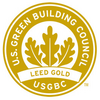
Leed Gold
Standard Owners (1)
| Name | Country | |
|---|---|---|
| LEED | 🇺🇸 United States |
About (Leed Gold)
LEED (Leadership in Energy and Environmental Design) is a widely recognized and globally accepted green building certification program. LEED Gold is one of the certification levels within the LEED rating system. Here are some key points about LEED Gold certification:
Sustainability Standards: LEED Gold certification is awarded to buildings that meet rigorous sustainability criteria set by the U.S. Green Building Council (USGBC). These criteria cover various aspects of building design, construction, operation, and maintenance, including energy efficiency, water conservation, indoor environmental quality, materials selection, and site sustainability.
Performance-Based Approach: LEED Gold certification takes a performance-based approach, requiring buildings to demonstrate measurable environmental benefits and high levels of sustainability performance. It encourages strategies and technologies that promote energy and water efficiency, reduce waste, enhance indoor air quality, and minimize environmental impact.
Verification Process: Achieving LEED Gold certification involves a thorough verification process conducted by independent third-party assessors. The process includes documentation review, on-site inspections, and performance testing to ensure compliance with the specified sustainability requirements. The assessors assess the building's design, construction, and operation, verifying its adherence to LEED standards.
Integrated Design Approach: LEED Gold certification encourages an integrated design approach, promoting collaboration among architects, engineers, contractors, and other project stakeholders. This approach aims to optimize building performance, enhance occupant comfort, and minimize environmental impact by considering multiple aspects of sustainability from the early design stages.
Recognition and Marketability: LEED Gold certification provides recognition for buildings that demonstrate a high level of sustainability and environmental responsibility. It signifies a commitment to sustainable practices and can enhance the marketability and value of the building. LEED-certified buildings are often preferred by tenants, investors, and occupants who prioritize environmental stewardship.
Continuous Improvement: LEED Gold certification encourages ongoing monitoring and improvement of building performance. It promotes the implementation of sustainable operations and maintenance practices to ensure long-term sustainability and optimal performance. Recertification is required every few years to verify that the building continues to meet the required standards.
LEED Gold certification signifies a significant achievement in sustainable building design and operation. It demonstrates a commitment to environmental responsibility, energy efficiency, and occupant health and well-being. LEED-certified buildings contribute to a greener built environment and help mitigate the environmental impacts of the construction industry.